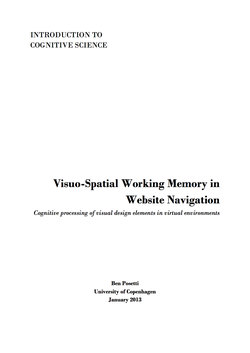Читать книгу Introduction to Cognitive Science - Ben Posetti - Страница 3
На сайте Литреса книга снята с продажи.
1. INTRODUCTION
ОглавлениеVisuo-Spatial Working Memory (VSWM) is the feature of cognitive working memory that temporarily stores and manipulates visuo-spatial input for use in processing (Logie, 1995). The concept was devised as a part of the Baddeley and Hitch (1974) original conception of working memory which entailed three elements: The visuo-spatial sketchpad which performs the functions of VSWM; the phonological loop performing a similar task for verbal (as opposed to visuo-spatial) material; and the central executive handling reasoning, decision making and coordinating the other two elements (Logie, 1995).
VSWM is a fundamental part of human cognition. It is involved in basic human tasks that use visual inputs such as body movements in space or navigation by mental mapping as well as basic processing of immediate visual stimuli. The thesis of this paper is that principles of VSWM can be applied to analyse cognitive load of individuals navigating in websites.
With the expansion of information publication facilitated by the internet, web users have a huge corpus of information and functions accessible through computing technologies. In this environment, a major challenge for web designers is to ensure navigability, accessibility and usability in a website. The field of Human-Computer Interaction (HCI) has emerged in the last 30 years, dealing with how people interact with technology practically and in cognition and communication. The field incorporates diverse areas such as cognitive science, anthropology, graphic arts, computer science, communications and ergonomics (Carrol, 2012).
Research in HCI has established the role of various cognitive processes in the design of websites. Vörös, Rouet and Pléh (2009) have investigated the role of a spatial map versus an alphabetical list in learning website hypertext content finding that they facilitate different learning. Vaughan and Dillon (2006) found that mental representations of a website were better established when subjects experienced a ‘genre-conforming’ web design that they were accustomed too.
Farris, Jones and Elgin (2002) suggested that users do not form spatial representations within websites in a study where participants drew a website’s organisations and tended to make connections based on semantic relations rather than the true hypermedia structure. However the participants still drew a spatial configuration, even if it was structured semantically, meaning that a spatial mental representation may still be present (Juvina, 2006).
Other results suggest that a cognitive spatial element is involved. Van Hooijdonk, Maes and Ummelen (2006) analysed users use of spatial verbalisations such as “There is more information behind this hyperlink” while cognitively processing websites being navigated. Vörös, Rouet and Pléh (2009b) also found that users with a high spatial capacity more accurately mapped a website than those with low spatial capacity.
This paper will discuss the processing of websites as a source of visuo-spatial input, within a visuo-spatial working memory paradigm. Considering some interesting findings on the architecture of VSWM, I will analyse how visual features are used in websites and reflect on what that means for visuo-spatial cognitive processing and overall website usability. This analysis will be rendered based on principles of visual representation in a HCI context, with examples of how those principles play out in navigation of actual websites.
In section 2.1 I will first introduce VSWM in detail as a part of the working memory system. Section 2.2 will discuss the most recent developments dealing with the distinction between visual and spatial information and how VSWM will be treated for the remainder of the paper. Section 2.3 describes various findings on how VSWM processes information in different ways, which are relevant when considering websites as visual and spatial input.
Section 3 begins by broadly introducing the field of web design and its role in today’s environment of information technology dependence. Prior HCI research into visual web design and its influence on usability is also presented. Section 3.2 relates the usability concept to VSWM and conceptualises usability for the purpose of discussing visual features in websites.
Section 4 analyses seven principles of visual representation in websites as introduced by Blackwell (2011): Typography and text, maps and graphs, schematic drawings, pictures, node-and-link diagrams, icons and symbols and visual metaphor. These are discussed in terms of how they are used in websites, the relevance of the presented VSWM findings that shed light on how those visual features are processed, and what that means for usability of websites. This discussion refers to many examples from existing websites including screenshots presented in the appendices. One example website, visitnorway.com, is closely analysed in section 4.8 demonstrating how many of the discussed factors in web design and VSWM integrate in the processing of a single website.
